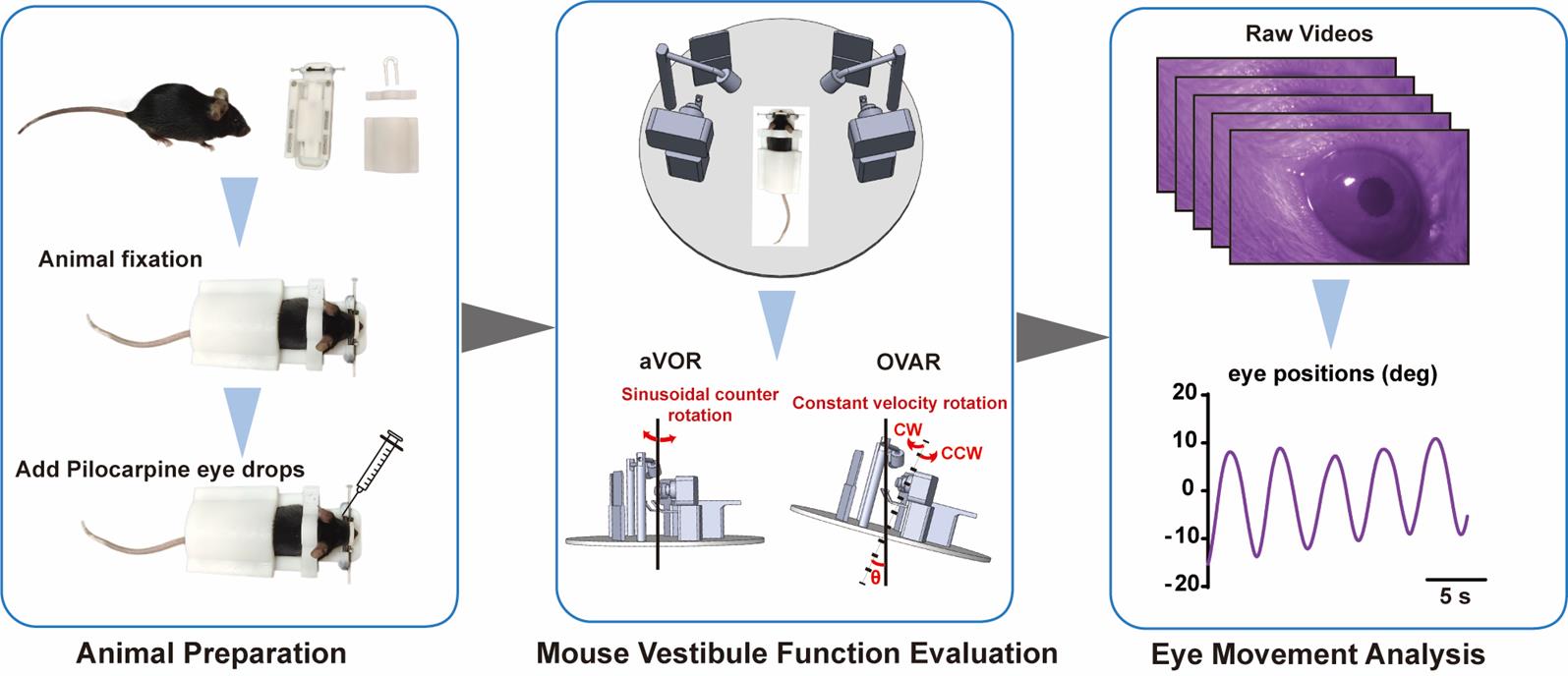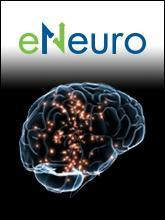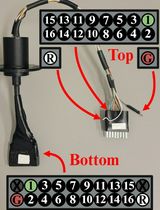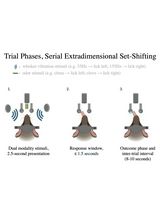- EN - English
- CN - 中文
Mouse Vestibulo-Ocular Reflex Testing for Otolith Organs and Horizontal Semicircular Canal
In Press, 发布时间: 2025年10月29日 DOI: 10.21769/BioProtoc.5509 浏览次数: 67
评审: Xiaochen SunAnonymous reviewer(s)
Abstract
Vestibulo-ocular reflexes (VORs) are compensatory ocular reflexes that maintain stable vision during head movements. In research, VORs encompass angular VOR (aVOR) and off-vertical axis rotation (OVAR) tests, which various groups have employed to assess vestibular function in mice. This protocol outlines the process for measuring VORs in mice, including eye rotation calibration, immobilizing the mouse with a noninvasive setup, configuring the aVOR and OVAR stimulus modes, and interpreting the obtained waveforms to derive VOR values. As technology advances, VORs are expected to yield more qualitative and quantitative insights into the function of the horizontal semicircular canal cristae (HSCC) and the otolith organs. This methodology can serve as a standard for evaluating common vestibular deficits in mice.
Key features
• The integrated aVOR and OVAR modes enable us to evaluate both the otolith organs and horizontal semicircular canals.
• The calibration tools used in our system ensure standardization between different systems, facilitating comparison of results between laboratories.
• Animal holders provide a rapid and convenient method for conducting VOR tests without the need for anesthesia or surgery.
Keywords: Vestibulo-ocular reflexes (VORs)Graphical overview

Background
The vestibular system detects changes in head and body position, controls gaze, and facilitates higher-level cognitive perception functions. It comprises three semicircular canals and two otolith organs (the utricle and saccule), which mediate sensitivity to rotational and linear (including gravitational) head movements, respectively. Vestibulo-ocular reflexes (VORs) are commonly used in clinical testing [1] and have also been part of standard vestibular function tests in primate studies [2–4]. VORs can be classified into angular VOR (aVOR), induced by rotational accelerations and primarily driven by signals from horizontal semicircular canal cristae (HSCC) [5,6], and translational VORs (tVORs), such as linear VOR (LVOR) and off-vertical axis rotation (OVAR), which provide otolith stimulus [7,8]. OVAR typically entails constant rotational velocity of the mouse head about an axis that is tilted to the Earth's vertical axis. After achieving steady state rotation, the semicircular canal response decays, and the resulting ocular response originates from otoliths [2,7]. LVOR response is too small to provide reliable estimates of otolith function [9], but OVAR signals are sufficiently robust, and OVAR stimulus could be easily combined with aVOR stimulus into one machine. Therefore, the combination of aVOR and OVAR can form the basis of a complete functional test for the peripheral vestibular organ. The purpose of this protocol is to provide a detailed procedure to encourage further study of the vestibular system's function.
Materials and reagents
Reagents
1. 0.5% Pilocarpine eye drops (Bausch + Lomb, ZhenRui@)
2. Stroke-physiological saline solution (Beyotime, catalog number: ST341-500 mL)
Laboratory supplies
1. 1 mL syringe (Beyotime, catalog number: FS801-180pcs)
Equipment
1. Noninvasive animal-immobility setup (Shenzhen Giant Tek Co., Ltd, catalog number: GT-MHOLDER1035)
2. VOG-based VOR test system (Shenzhen Giant Tek Co., Ltd, catalog number: GT-MVOR03)
3. Eye rotation calibration tools (Shenzhen Giant Tek Co., Ltd, catalog numbers: GT-MVCA01, GT-MVCA02, GT-MVCA03)
Software and datasets
1. Eye movement data processing software (Shenzhen Giant Tek Co., Ltd, catalog number: GT-MVORSW1.0). The software was created using MATLAB (2021b)
Procedure
文章信息
稿件历史记录
提交日期: Aug 24, 2025
接收日期: Oct 8, 2025
在线发布日期: Oct 29, 2025
版权信息
© 2025 The Author(s); This is an open access article under the CC BY license (https://creativecommons.org/licenses/by/4.0/).
如何引用
Readers should cite both the Bio-protocol article and the original research article where this protocol was used:
- Zhao, T., Xiao, S., Liu, Q., Liu, J. and Chen, F. (2025). Mouse Vestibulo-Ocular Reflex Testing for Otolith Organs and Horizontal Semicircular Canal. Bio-protocol 15(22): e5509. DOI: 10.21769/BioProtoc.5509.
- Xiao, S., Zhao, T., Liu, W., Peng, Z. and Chen, F. (2025). Semicircular Canals Input Can Modify the Fast-Phase Nystagmus in Off-Vertical Axis Rotation of Mice. eNeuro. 12(3): ENEURO.0461–24.2025. https://doi.org/10.1523/eneuro.0461-24.2025
分类
神经科学 > 感觉和运动系统 > 视觉系统
神经科学 > 行为神经科学 > 感觉运动反应
您对这篇实验方法有问题吗?
在此处发布您的问题,我们将邀请本文作者来回答。同时,我们会将您的问题发布到Bio-protocol Exchange,以便寻求社区成员的帮助。
提问指南
+ 问题描述
写下详细的问题描述,包括所有有助于他人回答您问题的信息(例如实验过程、条件和相关图像等)。
Share
Bluesky
X
Copy link












